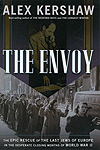
The Envoy: The Epic Rescue of the Last Jews of Europe in the Desperate Closing Months of World War II, by Alex Kershaw, Da Capo Press, 2010, $26
In the summer of 1944 Swedish businessman Raoul Wallenberg accepted his country’s request to travel to Budapest and lead a U.S.-supported diplomatic mission to rescue Hungary’s Jews from Nazi genocide. He arrived to find a somber, swastika-swathed city. Outside the Swedish Embassy stood a long line of Jews marked with Nazi-imposed yellow Stars of David, all seeking Swedish passports and the immunity from persecution such documents promised.
These Jews, and hundreds of thousands more, faced almost certain death. Adolf Eichmann, architect of Adolf Hitler’s “Final Solution” to the Jewish “problem” in Nazi-conquered Europe, had been directed to personally oversee the extermination of every Jew in Hungary and had taken up residence in Budapest to do so—even as the war’s tide was turning and Russian forces were approaching the occupied nation from the Eastern Front.
In The Envoy, Alex Kershaw recounts Eichmann’s cold-blooded implementation of the plan that sent nearly a half-million Hungarian Jews to their deaths at Auschwitz over a mere six-week period that summer. He also relates Wallenberg’s courage as he stood up to both Eichmann and the bloodthirsty, ultranationalist Hungarian Arrow Cross militias.
In the end Wallenberg helped save untold thousands of lives (estimates vary from 20,000 to as many as 100,000) by cleverly and brazenly employing a diplomatic ruse: the Schutzpass, a safe-passage document emblazoned with Sweden’s Tre Kronor (“three crowns”) emblem, which sufficiently impressed Nazi and Hungarian authorities. Kershaw acknowledges, albeit briefly, the contributions of others in the Swedish mission, including Charles Lutz, whose contributions are said to have equaled those of his fellow diplomat. But it was Wallenberg, Kershaw writes, “who had placed himself in the most danger, directly in the firing line, in the crosshairs of the SS and Arrow Cross.”
Kershaw recounts the tale in brisk and riveting fashion, drawing from survivor interviews as well as the extensive historical record—the footnotes run 44 pages. One can sense the doom on Budapest’s increasingly mean streets after the October 1944 putsch that handed the Arrow Cross the political reins. “The pogroms began that very evening,” Kershaw writes. “Hundreds were pulled from their homes or off the streets and slaughtered in plain sight.…Forced laborers were marched to bridges across the Danube, shot, and their bodies dumped into the river.”
Three-quarters of the way through the book, however, Wallenberg disappears into the fold of the occupying Soviets (his fate remains largely a matter of conjecture), and the pace of the narrative becomes erratic—slowing to recount the postwar lives of Jewish survivors; accelerating with the tense and ultimately successful Israeli hunt for Eichmann.
It may have been an impossible task—given the murky nature of Wallenberg’s fate—to weave these somewhat disparate postwar threads into a more cohesive denouement. That said, Kershaw’s pace through most of the book makes The Envoy a compelling read. His depictions of Wallenberg’s confrontations with Eichmann and the other monsters he faced are vividly drawn.
—William H. McMichael




